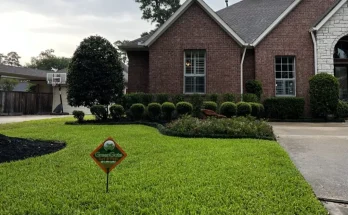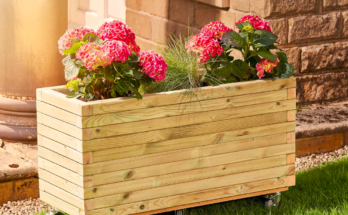It is important to choose the right playground surfacing. It should adhere to safety standards and have a high level of shock absorption. To ensure that kids are not exposed to harmful chemicals, the surface should be chemical-free. The flooring should also be easy to install and durable enough to endure heavy foot traffic for many years.
It is important to know the pros and cons of artificial turf for playgrounds. This post will provide you with all the information you need about playground surfacing made of artificial turf. Take a look at the information shared to help you make an informed choice when creating a play area that is safe and accessible for children of all ages.
Artificial Turf – What Is It?
Artificial turf is made from synthetic fibers that resemble real grass. Some manufacturers now refer to this product as artificial grass. Polyethylene and polypropylene are the most commonly used fibers for artificial turf. These fibers contribute to the grass-like look and feel of artificial turf. Synthetic turf requires less maintenance than real grass.
As children play, the multiple layers of fibers in synthetic turf provide cushioning. It is important to determine whether artificial turf will reduce the impact of critical falls.
Here are the main pros and cons of artificial turf. These will help you decide if these surfaces are suitable for playgrounds.
Pros
- Artificial turf is less expensive to install and maintain than natural grass. It does not require mowing, irrigation, pesticides, fertilizers, or watering.
- Artificial turf is pollen-free, reducing the risk of children getting hay fever or other allergies. Insects tend to avoid synthetic grass.
- You can choose the fibers used to make synthetic turf. You can customize the turf to meet your needs, from the color, style, texture, and density of its fibers to its height.
- You don’t have to replace all the turf if it is damaged. You can cut and replace damaged sections with the help of professionals.
- Artificial turf surfaces will not leave stains on children’s clothes.
Cons
- Artificial turf does not meet the American Standard Testing Methods for high shock absorption. To achieve the fall height required for safety, it needs to be padded and filled with infill. Therefore, artificial turf is not the best option for a safe and accessible play area.
- It is less durable than other materials on the market. It may not withstand the wear and tear of playgrounds and can splinter. The surface can also warp in areas of extreme temperature changes.
- The fibers accumulate dust, leaves, and sand. Regular cleaning of the artificial grass is required to maintain hygiene and a good appearance. The surface can become warped and lose its appeal in a matter of years.
- Artificial turf often struggles with water accumulation, making it a tripping hazard. The surface material must be rinsed frequently to ensure proper drainage.
- Although the artificial turf may be ADA-compliant, the gap between the rolls of material can prevent children with disabilities from using mobility aids like wheelchairs or walkers.
Why Is Rubber Surfacing the Best Option for Playground Surfacing?
Rubber playground surfacing has emerged as the most popular option on the market. Rubber surfacing is preferred by daycare directors over artificial turf because of its high safety rating. Rubcorp offers top-quality rubber surfacing products that meet ADA safety standards.
Learn about the pros and cons of rubber flooring for playgrounds.
Pros
- Rubber surfaces conform to ASTM guidelines on critical fall height. They provide high shock absorption to reduce the impact of slips and falls.
- Rubber surfacing, unlike synthetic turf, is durable, springy, and does not splinter. It can withstand high foot traffic without significant wear.
- Rubber surfaces comply with ADA standards. They meet all accessibility requirements, allowing kids with disabilities to safely use their mobility aids.
- Rubcorp adheres to high standards. The company offers premium rubber materials made from Ethylene-propylene Diene monomer rubber granules (EPDM) and Styrene-butadiene rubber (SBR). These materials are resistant to cracking in extreme weather conditions and do not contain harsh chemicals. Children can play without worrying about skin allergies.
- Rubcorp has a wide range of EPDM colors to complement play areas and make them appealing for children.
- Rubber surfaces, unlike artificial grass, are easy to maintain and clean. They can last up to 15 years without much maintenance.
Cons
- Rubber surfacing has a higher initial cost than synthetic turf. However, it will last several years and won’t require as much maintenance as artificial turf. High-quality rubber will last a long time.
- Rubber surfaces are difficult to install. It’s important to seek the assistance of rubber surfacing specialists like Rubcorp. Our team of professionals will make the process easier and faster.
To Sum Up
Both rubber and artificial turf have their advantages and disadvantages. Rubber surfaces are a better option than artificial turf for playgrounds when it comes to safety standards. Rubber surfaces are resistant to heavy foot traffic, durable, and anti-slip. Rubber surfacing can be used to create a safe and fun play area for children.
This post was written by a professional at Sustainable Turf. Looking for the best residential artificial turf Clearwater? At Sustainable Turf, we believe in offering sustainable, eco-friendly solutions that benefit both homeowners and the environment. Our artificial grass for playgrounds, homes, and more are designed to provide you with a beautiful, low-maintenance lawn that requires minimal resources to thrive. By choosing our artificial turf, you’ll enjoy a wide range of benefits for years to come. Contact us now for estimate for your sports turf field, residential turf, golf putting turf, and more!




